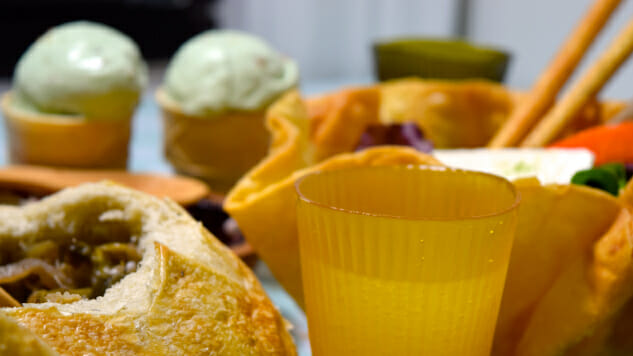Edible Tableware Lets You Have Your Plate and Eat It, Too
At this meal, everything except the tablecloth is on the menu.
Photos by Madina Papadopoulos
My parents never took me to Disneyland. I didn’t mind. I had my heart set on a place that didn’t exist: Willy Wonka’s Chocolate factory. Now grown, I still cling to the hope that some mad genius (Bompas & Parr?) will recreate the edible world in Willy Wonka’s candy factory. The moment in the film when Gene Wilder wrapped up his song “Pure Imagination,” sipped tea out of a flower-shaped teacup, and then took a bite out of it made my imagination purely soar.
After taking a look at various food blogs, I can see I’m not the only person with a piqued interest in edible tableware. One of the best recent food trends has been all of the edible receptacles (made of Jell-O, cookie dough, or fruit) that enthusiasts create at home. Since no one has built Wonka Land yet, I satisfied my dreams by treating myself to a fully edible dinner. Fortunately, there are a few very cool products popping up on the market…and, if my wishes come true, there will be more.

Glassware was by far the easiest to find. Loliware was on Shark Tank earlier this year, with industrial designers Chelsea Briganti and Leigh Ann Tucker presenting their delicious cups made primarily from seaweed. On top of coming up with a totally adorable product that aims to help the environment, they came up with a totally adorable tagline: biodegr(edible).
For those who love those #cookiecups flooding Instagram but aren’t good at baking, ChocAmo sells a delectable, readymade kind. Initially created by student Michelle Silberman for her seventh-grade science project, Silberman revisited the concept once she grew up; she’s now an entrepreneur with her own business.
Unfortunately, I couldn’t find any company manufacturing edible plates. But this was merely a small hiccup, as some edible bowls already play a part of food culture. As a lover of Mexican food, I ate my first taco salad bowl long ago. As a fan of medieval history, I’m familiar with the bread trencher. The bread bowl I fashioned from La Brea Bakery loaf, and the taco bowl was from from Noche Mexicana.
The most difficult to find, as is easy to imagine, were the utensils. I looked long and hard for these, and only came up with one utensil for sale, coming all the way from India (it seems that edible tableware is an international movement). A company called Bakeys, started in Hyderabad, India, by scientist Narayana Peesapaty. Through edible utensils, Peesapaty’s goal is to address the environmental concerns of disposable cutlery. His solution is appetizing. So far, Bakey’s has a flour-based spoon, and is designing a fork and chopstick. I searched for an edible fork, but to no avail. My friend, an architect at Google and quite clever, recommended I use grissini (thin, crisp, Italian breadsticks) as chopsticks. So I did.
-

-

-

-

-

-

-

-

-

-

-

-

-

-

-

-

-

-

-

-

-

-

-

-

-

-

-

-

-

-

-

-

-

-

-

-

-

-

-

-












































